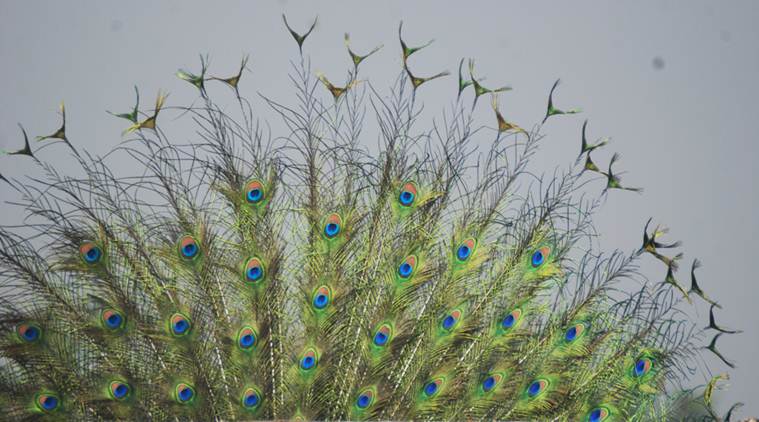 So you think you can dance? A peacock, unfurled. (Source: Ranjit Lal)
So you think you can dance? A peacock, unfurled. (Source: Ranjit Lal)
The callow young guns have been practising their steps since February — when their costumes weren’t even ready. The ladies watched them with amused derision: “These guys, look at them, they are dancing in their boxers!” By the time the monsoon hits, the gents in full, regal tapestry will be unfurling their gorgeous blue and green-eyed fans with elaborate extravagance and proceed to impress the ladies with their shimmering, zithering performance. The ladies still affect indifference, but they have got their eyes on the fellows with the most dazzling eyespots.
I’m, however, moved more by the spirit-lifting dance of the Sarus cranes than that of peacocks. There’s a joyous exuberance about the way pairs throw up their skirts and legs and leap and trumpet, inviting the whole world into their declamations of love. The pairs remain loyal to each other for life.
Others, too, put on fabulous cabarets and shows. The male birds of paradise, with kaleidoscopic costumes and displays, step out to stun the girls in every tropical rainforest island where they are found. In Ecuador and Colombia, the scarlet and black manakin does a moonwalk routine, which may or may not have “inspired” Michael Jackson. In the Americas, Clark’s grebe do a “walk on water” display where both partners stand up and, with wings stiff by their sides, flurry across the water, side by side, at 20 steps a second for more than 20m! Then they tenderly exchange weeds as gifts. Gentlemen flamingoes put on a massed march past, snapping their heads this way and that — like a militaristic ballet performance. Ostrich gentlemen do a seductive number what with all their fluffy can-can plumes and flip-flop feathers, crouching and pirouetting and being coy.
Not just birds. The mantis shrimp — the little guy who could out-punch Mike Tyson — and who lives underwater — has a graceful routine for his lady. Seahorse couples entwine tails and go dancing in the deep for days as they get to know each other. Freshwater algae are known to waltz and do the minuet: colonies link their long slender flagella together and move back and forth as if connected to each other with elastic bands! The humpback whale gentleman summons his beloved with a melancholic song and then waltzes with her in the deep-blue depths.
Creepy-crawlies have their moves too. The peacock spider is a well-known mover and shaker. The male spider’s and scorpion’s objective is to not get eaten by his ladylove, keeping her mandibles and sting out of reach. Bees do their famous “waggle” dance, though the reason is not romantic. Their waggle dance at the hive instructs the others regarding the location of a good source of nectar. Mama shrews, with their frenetic lifestyles and too many babies to look after, organise a “conga line” with their little ones — each baby clamping itself to the tail of the one in front of it and moving along with mama in the lead. That wacky lemur, the sifaka from Madagascar, has very long legs and very short arms and skims across the ground with a graceful ballet-like sideways motion.
Only humans and a small coterie of animals are truly able to dance, so say scientists. As dance demands the ability to move in synchrony with an external rhythmic beat, very few animals can do this. They find a neural link between the ability to synchronise with an external beat and the ability to mimic. If you can’t mimic and, hence, vocalise, you really will not be able to tune into a beat — or dance. Parrots, among a few others, can do this. The rock star among them is the sulphur-crested cockatoo Snowball, who is able to rock and roll in time with changing beats. Around nine others species of birds and the Asian elephant, chimpanzees and bonobos, are said to have this ability too, either as “vocal” or “motor” (the chimps) imitators. One swinger that has neither of these talents yet dances to a beat is the Californian sea lion. It has caused scientists to scratch their heads in wonderment. It is now being thought that the neural mechanisms required for flexible beat-keeping may be found in more animals than was previously believed.
What’s funny is that we’ve been dancing probably since the time we stood up on two legs and learnt to walk. Tribal dances, hip hop, ballet, conga, rumba, lambada, waltz, twist and what have you, you can almost always find some animal, bird, insect, even fish that has been making the same moves since time immemorial. It’s a chicken-and-egg conundrum, who mimicked whom first — the manakin or Jackson? We have just added the beat and music and then decreed that only we can dance.
Ranjit Lal is an author, environmentalist and bird watcher.